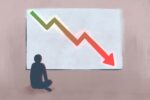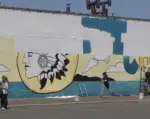COVID-19 has disproportionately harmed the most vulnerable communities in the United States and laid bare much of the nation’s issues in regards to health care, economics and social services. And it is doing irreversible harm to Indigenous communities all throughout the country.
The Navajo Nation is the largest Indigenous reservation in the United States, with over 173,000 people within its borders. It spreads across Utah, Arizona and New Mexico — and it’s been hit by COVID-19 hard. The community has the highest COVID-19 infection rate in the country at 3.4%. For comparison, at its highest, New York’s infection rate was 1.9%. As of early June, Native Americans in Chicago had a COVID-19 mortality rate of 15%, three times higher than the city’s overall mortality rate of 5%. A study conducted by the American Indian Studies Center at UCLA found that if Indigenous tribes were counted as states, they would be the top five most infected states in the country.
In an interview with a New York Times columnist, Navajo Nation member Naiyahnikai Gorman said, “COVID-19 is a way of history repeating itself. Us Native Americans have experienced, throughout history, diseases and illnesses, and it is happening again through marginalization, the lack of acknowledgement and respect for us as a people and being unable to unite as one people.”
https://www.instagram.com/p/CAxpjv3g3m6/
During the 1918 influenza, Indigenous communities suffered four times the average mortality rate of the general population. Almost a century later, Indigenous people are facing the full force of a pandemic once more.
Indigenous communities are more susceptible to pandemics like COVID-19 due to social determinants of health. According to the Journal of Rural Health, social determinants of health are “nonmedical factors that impact health” and include social factors such as “poverty, low educational status, crowded living conditions, household air pollution, lack of running water that makes washing hands challenging, [and] inadequate access to health care due to chronic underfunding of the healthcare system.”
One of the reasons the pandemic has hit the Navajo Nation so severely is because of a lack of infrastructural resources throughout the reservation. Only about 40% of homes in the Navajo Nation have access to running water. This makes preventative care, such as washing one’s hands, very difficult. The disparity is seen in Indigenous communities throughout the country. According to the John Hopkins Center for American Indian Health, 12% of homes on reservations do not have access to water. In comparison, only 0.6% of households nationwide lack water.
The Navajo Nation, among many other Indigenous tribes, signed treaties with the U.S. government in the late 1800s, giving up much of their land in return for funding for infrastructure such as running water, housing and education. It has been over 150 years, and the terms of the treaties are not being upheld. A 2018 report to Congress compiled by the Indian Health Service revealed that the Navajo Nation has $450 million in unfunded requests to Congress. Requests for funds and resources necessary to provide water to reservations have been largely ignored. And the consequences have been fatal.
Indigenous communities throughout the United States have high rates of illnesses such as diabetes, high blood pressure and heart disease. This is due to the fact that many reservations are located in food deserts, areas with limited access to affordable and nutritious food. Despite covering over 27,000 square miles, the Navajo Nation only has 13 grocery stores. For most residents, the nearest grocery store is a three-hour drive away.
As a result, most of the residents’ dietary needs are met by purchasing chips or carbonated beverages from convenience stores, thus increasing the occurrence of various health issues. One in five Navajo adults has diabetes, and 50% of Navajo children are obese.
According to an article from Planet Forward, an environmental news organization, “Many of the Navajo people’s economic and health struggles can be directly traced to the neglectful and violent way the U.S. government has treated the tribe for centuries. For example, the Navajo Taco dish has a dark history, as it was created out of necessity when the Bureau of Indian Affairs was rationing the tribe’s access to food staples like flour and salt.”
A lack of basic necessities, such as food and water, has amplified the effects of COVID-19 on this community and made it clear that action must be taken immediately to protect Indigenous people from more harm. However, government action has been anything but swift or holistic.
On March 27, under the Coronavirus Aid, Relief, and Economic Security Act, Indigenous communities were promised $8 billion in COVID-19 relief funds. As part of the law, the funds had to be distributed no later than 30 days after its enactment. However, the funds were not given to Indigenous communities until 80 days later, and by that time, death tolls across reservations had risen tremendously. The delay in funds prevented Indigenous communities from creating a comprehensive response plan, and the resulting damage has been devastating.
Furthermore, by blocking access to data about COVID-19 in Indigenous communities, the government has made it difficult for tribal leaders to adequately understand and respond to the outbreaks in their communities.
According to a report by POLITICO, “The Centers for Disease Control and Prevention has turned down tribal epidemiologists’ requests for data that it’s making freely available to states.” At the time the report was published, the CDC had not responded to questions about the matter, but tribal leaders have called the refusal to give information a “chronic failing” of the U.S. public health system.
Other policies, such as medical forms not having Native Americans as a racial category in states such as Massachusetts, New York and New Jersey, make it difficult to get accurate data on the effect of the pandemic in the Indigenous community.
Now, as more states open up and infection rates rise, it is important to support the country’s most vulnerable populations.
The NDN collective, a nonprofit dedicated to uplifting Indigenous people, has created a response project to provide support to Indigenous communities dealing with COVID-19. According to their website, they have “approved more than $2,500,000 in grants to more than 95 partners in 23 states, including over 16 tribal entities, impacting over 200 Indigenous communities across North America.” Individuals wishing to support the initiative can donate on the project’s page.
COVID-19 has laid bare many of the institutional failures of the United States government. Years of neglect and disrespect of treaties made with Indigenous tribes have culminated in irreparable damage to their communities. Although the lives lost cannot be restored, the government has both a moral and legal obligation to address this harm and to invest in Indigenous communities.

















